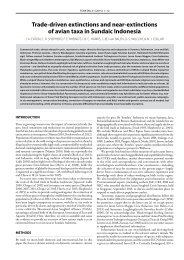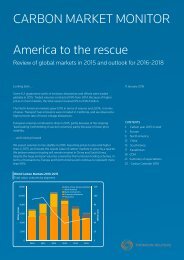Emissions Trading Worldwide
1TbjEHd
1TbjEHd
You also want an ePaper? Increase the reach of your titles
YUMPU automatically turns print PDFs into web optimized ePapers that Google loves.
New Zealand <strong>Emissions</strong> <strong>Trading</strong> Scheme (NZ ETS)<br />
in force<br />
emissions coverage (Mtco 2 e, 2015)<br />
Liable entities<br />
38.6 2423<br />
Gas coverage<br />
allocation<br />
Offsets & Credits<br />
SEVERAL gases<br />
auctioning & free allocation<br />
international until May 2015 & domestic<br />
The NZ ETS was launched in 2008, and has since continued to<br />
evolve to cover all sectors of the economy, including agriculture,<br />
which currently has reporting but not surrender obligations. The<br />
first statutory review was completed in 2011 and the NZ ETS was<br />
amended in 2012. A second review of the NZ ETS is currently<br />
underway and is expected to conclude in the second half of 2016.<br />
It is focusing on three areas: transition measures that moderate<br />
the scheme’s impact, how the NZ ETS may need to evolve to assist<br />
New Zealand in meeting its 2030 target, as well as operational and<br />
technical improvements.<br />
The NZ ETS was originally designed to provide unlimited access<br />
to international credits. However, the NZ ETS restricted the use of<br />
international Kyoto units (CERs, ERUs, and RMUs) as of 1 June 2015,<br />
effectively making it a domestic-only system. This may change in<br />
the future, as access to international markets is a priority indicated<br />
in New Zealand’s INDC.<br />
Also in 2015, the Government allocated funding to support<br />
work on supply management, including auctioning allowances,<br />
which could be used to respond to future supply constraints.<br />
background information<br />
Overall Ghg <strong>Emissions</strong> (excl. LULUCF) 81 MtCO 2 e (2013)<br />
OVERALL GHG EMISSIONS BY SECTOR<br />
MtCO 2 e<br />
emissions coverage<br />
covered<br />
not covered<br />
52%<br />
48%<br />
Coverage with surrender obligations. <strong>Emissions</strong> coverage with reporting obligations: ~98%<br />
GHG Covered CO 2, CH 4, N 2 O, SF 6, HFCs and PFCs<br />
Sectors & THRESHOLDS Sectors were gradually phased-in over time. 2008:<br />
Forestry (mandatory: deforesting pre-1990 forest land, voluntary: post-1989<br />
forest land). 2010: Stationary energy (various thresholds), industrial processing<br />
(various thresholds) and liquid fossil fuels (various thresholds). 2013: Waste<br />
(except for small and remote landfills) and synthetic GHGs (various thresholds).<br />
Synthetic GHGs not in the NZ ETS are subject to an equivalent levy. Biological<br />
emissions from agriculture must be reported, but face no surrender obligations.<br />
Point of regulation The point of obligation is generally placed upstream.<br />
Some large businesses that purchase directly from mandatory NZ ETS participants<br />
can choose to opt into the NZ ETS rather than have the costs passed<br />
down from their suppliers.<br />
Number of liable entities 2,536 entities registered, of which 2,468 have surrender<br />
obligations (as of June 2015). 1. 261 entities with mandatory reporting<br />
and surrender obligations. 2. 2,207 entities with voluntary reporting and surrender<br />
obligations; mostly for forestry activities. 3. 68 entities with mandatory<br />
reporting without surrender obligations; mostly for agricultural activities.<br />
Phases and Allocation<br />
6.3 %<br />
Industrial processes,<br />
solvent and other products use (5.1)<br />
agriculture (39.2)<br />
44.7 % 6.3 %<br />
21.7 % 17.3 %<br />
Waste (5.1)<br />
energy (excl. transport) (17.6)<br />
transport (14)<br />
GHG Reduction Targets By 2020: 5% reduction from 1990 GHG levels (unconditional<br />
target). BY 2030: 30% reduction from 2005 GHG levels (equivalent to<br />
11% reduction from 1990 GHG levels) (INDC Submission). BY 2050: 50% reduction<br />
from 1990 GHG levels.<br />
ets size<br />
Cap The NZ ETS has no fixed cap, in order to accommodate carbon sequestration<br />
from forestry activities and to enable the full use of international carbon<br />
markets. The NZ ETS legislation includes provisions to introduce auctioning of<br />
New Zealand Units (NZUs) within an overall cap on non-forestry sectors.<br />
<strong>Trading</strong> periods For most sectors the NZ ETS has year-on-year allocations<br />
and surrender obligations.<br />
For post-1989 forestry participants annual reporting of emissions and removals<br />
is optional, with five-year mandatory reporting periods. As a result, unit entitlement<br />
transfers and surrender obligations for these participants correspond to<br />
when they choose to report their emissions.<br />
allocation Intensity-based allocation for the industrial sector (26 eligible<br />
activities): 90% free allocation for highly emissions-intensive and trade<br />
exposed activities (1,600 tCO 2e/NZD 1 million of revenue [EUR 618,442]). 60%<br />
free allocation for moderately emissions-intensive and trade exposed activities<br />
(800 tCO 2e/NZD 1 million of revenue). In the year to June 2015, 5.1 million NZUs<br />
were allocated to industrial participants, compared to a total of 32.1 million<br />
certificates (primarily Kyoto units) surrendered in this period. Forestry and fisheries<br />
sectors: Owners of pre-1990 forest land received a one-off free allocation<br />
of NZUs to partially compensate for the impact of the introduction of the NZ<br />
ETS on land use flexibility. Fishing quota owners were also compensated for<br />
rising fuel costs with a one-off free allocation. See ‘offsets and credits’ for information<br />
on unit entitlements for the post-1989 forestry sector. In 2012, the NZ<br />
international carbon action partnership<br />
55




